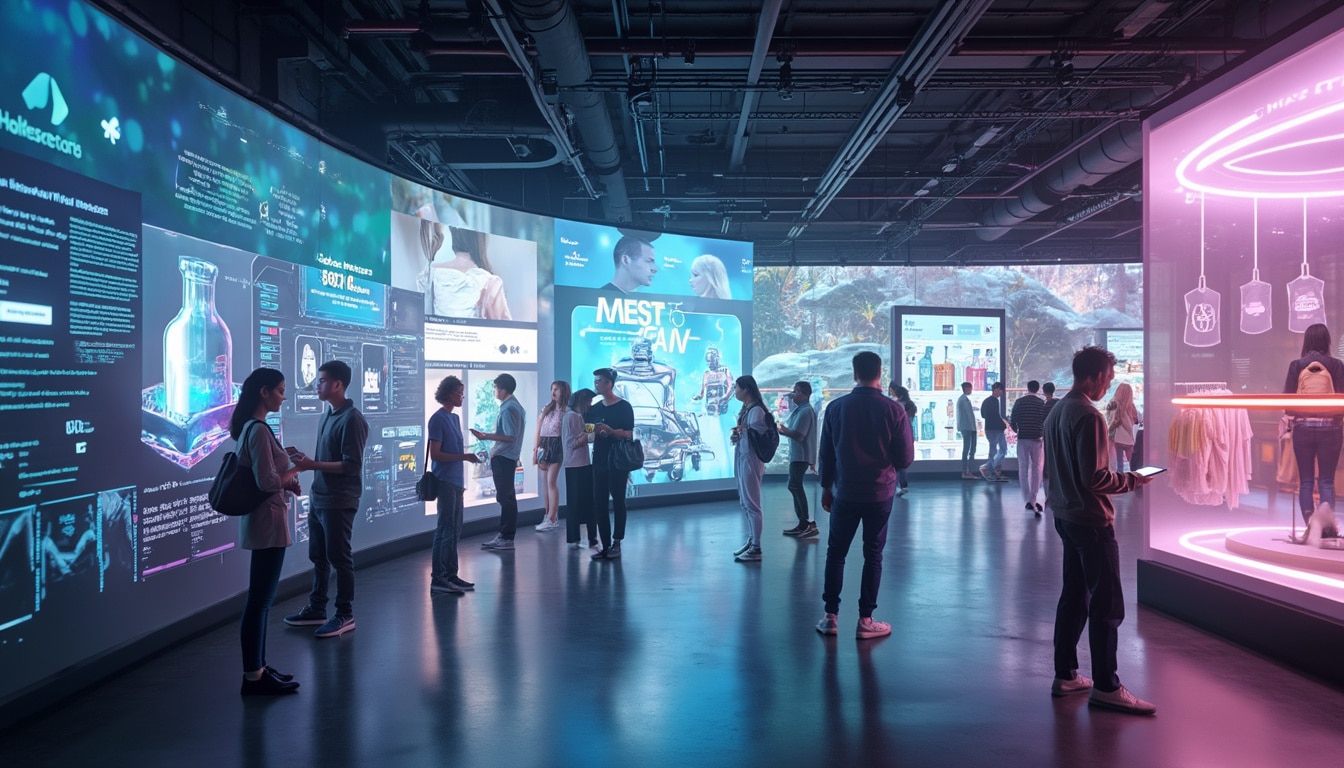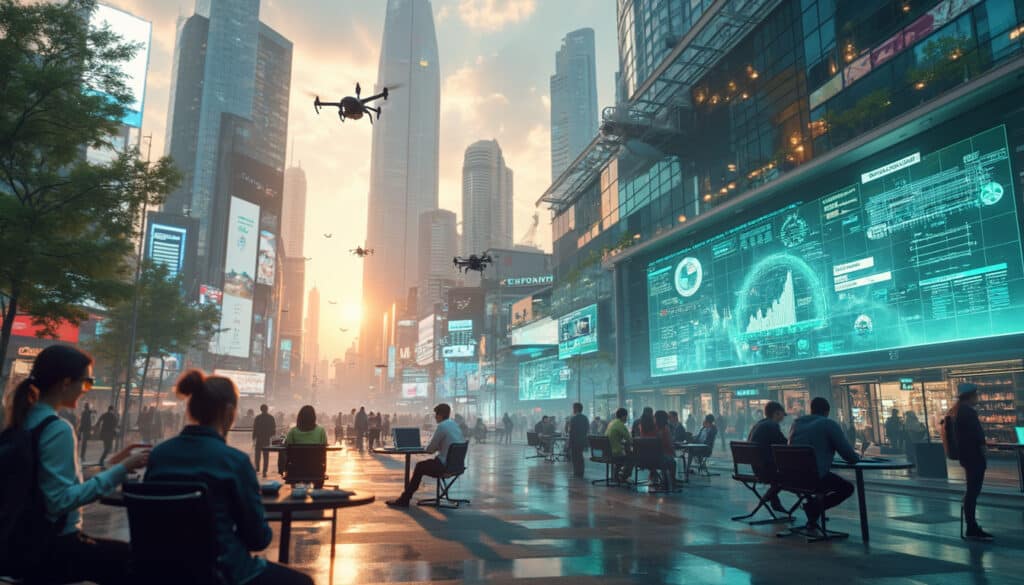The future of online commerce looks revolutionary thanks to the latest technological advancements.
AI-powered shopping agents are already transforming the way consumers interact with brands.
By 2025, half of all online searches will be voice-activated.
These developments open up unprecedented opportunities for companies looking to strengthen their digital presence. The trends identified by NetElixir perfectly illustrate this paradigm shift. Let’s review the main transformations that will redefine the landscape of e-commerce in the coming years.
🔥 Nous recommandons Elementor
Créer un site e-commerce en quelques clics avec Elementor. Ne nécessitant aucune connaissance en développement web, Elementor est LA solution disponible à tous pour créer un site qui attirera les acheteurs.
Social commerce: Social platforms will contribute to more than 10% of online transactions, thanks to improved shopping integrations on networks like Instagram and TikTok.
Voice-activated conversational search: Traditional search bars will be replaced by voice assistants and smart chatbots, making interactions more intuitive and personalized.
Hyper-personalized shopping experiences: Advanced use of AI and machine learning will enable the creation of tailor-made experiences that align with consumers’ individual preferences.
Marketing driven by AI shopping agents: These agents will provide ultra-personalized recommendations, enhancing loyalty and increasing conversion rates.
AI-powered marketing experimentation: AI will facilitate content creation, campaign optimization, and budget allocation more effectively than ever before.
Introduction of AI agents in e-commerce: These agents will manage complex tasks, reducing human reliance and increasing operational efficiency.
Conscious commerce: Sustainability is becoming a key factor, with 70% of consumers prioritizing brands aligned with their environmental and social values.
Integration of augmented and virtual reality: These immersive technologies will offer interactive and memorable shopping experiences, further personalizing the customer journey.
Emergence of luxury and discount marketplaces: Marketplaces are diversifying to meet the varied needs of consumers, with platforms dedicated to exclusivity and others focused on accessibility.
Explosion of creativity thanks to AI: AI-powered tools will open new perspectives in creative storytelling and content creation, allowing companies to elevate their marketing strategies.
#>

Table of Contents
ToggleThe rise of social commerce
Social commerce is booming and is expected to account for more than 10% of online commerce by 2025. Platforms like Instagram and TikTok are continuously improving their shopping integrations, thus facilitating transactions directly from social networks. This evolution underscores the growing role of social media in consumers’ purchasing decisions. Brands are investing more in social commerce strategies to capture users’ attention where they already spend a large part of their time.
The increase in shopping features on these platforms allows users to discover and purchase products without leaving the app. For example, the new shopping features on Instagram allow for a seamless and immersive shopping experience. Moreover, influencers play a key role in authentically promoting products, thereby enhancing consumer trust and driving sales.
To capitalize on this trend, businesses must optimize their presence on social networks, collaborate with relevant influencers, and offer user-friendly shopping experiences. An effective social commerce strategy can not only boost sales but also enhance brand loyalty by creating an engaged community around the offered products and services.
Voice-activated conversational search
By 2025, 50% of all online searches are expected to be voice-activated. This trend is driven by the rise of voice assistants and AI-powered chatbots, which are gradually replacing traditional search bars. This transformation makes interactions with online stores more intuitive and natural, providing an enhanced user experience.
Optimization for voice search is becoming essential for businesses looking to capture this growing segment of consumers. It’s no longer sufficient to focus solely on traditional keywords; it is crucial to think in terms of complete phrases and questions that users might ask vocally. For example, incorporating phrases like “where can I buy” or “best products for” can improve visibility in voice search results.
Furthermore, implementing smart chatbots allows for 24/7 customer support, responding quickly to customer inquiries and facilitating transactions. These tools can also customize product recommendations based on individual preferences, thus increasing conversion rates and customer satisfaction.
Unified and hyper-personalized shopping experiences
The convergence of advancements in AI/ML, real-time data utilization, demand for personalized experiences, and the rise of connected devices will drive revolutionary innovations in the personalization of shopping experiences. Consumers now expect engaging, efficient, and highly personalized interactions that correspond to their individual preferences.
The use of real-time data allows businesses to track user behavior, anticipate their needs, and provide relevant product recommendations. For example, advanced algorithms can analyze shopping habits and suggest items that may interest each user, thus increasing the conversion rate.
In addition, the integration of technologies such as augmented reality (AR) and virtual reality (VR) offers immersive shopping experiences. These technologies allow customers to visualize products in their real environments before making a purchase, thus reducing uncertainty and returns. To learn more about the integration of AR/VR in e-commerce, check the latest web design trends.
The marketing driven by AI shopping agents
AI shopping agents are poised to revolutionize customer engagement by providing hyper-personalized recommendations that drive loyalty and conversion. This innovation redefines how businesses interact with their audiences, making purchasing processes more intuitive and tailored to individual needs.
AI shopping agents analyze customer data to understand their preferences and shopping behaviors. Based on this information, they can suggest relevant products, anticipate future needs, and offer proactive assistance. This personalized approach enhances the customer experience and increases the likelihood of conversion by offering solutions tailored to each user.
Moreover, these agents can autonomously manage many complex tasks, thereby reducing reliance on human interventions and increasing operational efficiency. By automating processes such as customer service and order tracking, businesses can focus on broader and more innovative growth strategies.
AI-powered marketing experimentation
Artificial intelligence allows for unprecedented advances in content creation, campaign optimization, and budget allocation. Through sophisticated algorithms, businesses can quickly test and iterate their marketing strategies, thereby maximizing their effectiveness and return on investment.
AI tools analyze campaign performance in real time, identifying the most effective elements and adjusting strategies accordingly. This capability for continuous experimentation allows marketers to remain agile and quickly adapt to market changes and consumer preferences.
Furthermore, AI can optimize advertising budget allocation by identifying the most profitable channels and segments. This allows for a more efficient use of resources, maximizing the impact of marketing campaigns and reducing unnecessary expenditures.
To discover the trends influencing B2B digital marketing, explore the best practices for marketing experimentation.
The introduction of AI agents in e-commerce and marketing
AI agents will increasingly manage complex tasks in e-commerce and marketing, reducing human dependency while increasing efficiency. By automating routine processes, these agents allow businesses to focus on strategic growth and innovation.
AI agents can handle aspects such as inventory management, order processing, and even content creation. This automation frees up time for human teams, allowing them to dedicate themselves to more creative and strategic initiatives, such as developing new campaigns or analyzing data to identify market opportunities.
Additionally, AI agents can provide in-depth analyses and accurate forecasts through machine learning, helping businesses make informed decisions based on reliable data. This not only improves operational efficiency but also enhances companies’ ability to swiftly adapt to market changes.
To learn more about web marketing strategies and trends for 2025, discover how AI agents are transforming the landscape of digital marketing.
Conscious commerce
Sustainability is now at the forefront of purchasing decisions, with 70% of consumers worldwide preferring brands that share their values. Conscious commerce is becoming a key differentiator for building trust and customer loyalty.
Companies must integrate sustainable practices into their operations and communicate transparently about their environmental initiatives. This includes the use of eco-friendly materials, waste reduction, and the adoption of ethical practices in the supply chain. In response to this demand, many brands are adopting sustainability certifications and labels to reassure consumers about their commitments.
Conscious commerce is not just limited to environmental aspects; it also encompasses social and economic dimensions, such as fair trade and support for local communities. By adopting a holistic approach, companies can not only attract ethically-minded consumers but also make positive contributions to society and the environment.
To explore further, check the digital commerce trends focused on sustainability.
The integration of augmented and virtual reality
Immersive technologies such as augmented reality (AR) and virtual reality (VR) are transforming the online shopping experience. By 2025, the AR market is expected to reach 50 billion dollars, offering consumers interactive and memorable shopping experiences that enhance personalization.
AR allows customers to visualize products in their real environments before purchasing them, thereby reducing uncertainties and returns. For example, a furniture app in AR can help a customer see what a chair would look like in their living room, thus facilitating decision-making. Similarly, VR offers immersive experiences where users can explore virtual stores, trying on clothes or interacting realistically with products.
These technologies not only enhance the user experience; they also create opportunities for innovative marketing strategies. Businesses can host virtual events, interactive product demos, and immersive advertising campaigns that capture consumers’ attention and strengthen engagement.
To learn more about the impact of AR/VR in e-commerce, consult these web design trends in New York.
The emergence of luxury and discount marketplaces
The marketplace landscape is evolving to meet the diverse needs of consumers, giving rise to distinct segments dedicated to luxury and discount products. This segmentation reflects the changing priorities of consumers, who seek either exclusivity or accessibility.
Luxury marketplaces emphasize exclusivity, offering high-end products, limited editions, and personalized services. These platforms attract clientele seeking highly personalized shopping experiences and premium quality products. In contrast, discount marketplaces focus on accessibility and competitive pricing, attracting budget-conscious consumers.
This dichotomy allows businesses to better target their audiences and meet the specific expectations of each segment. Luxury marketplaces can invest in exclusive shopping experiences and partnerships with prestigious brands, while discount marketplaces can focus on attractive offers and a wide range of affordable products.
To discover how marketplaces are evolving, check the digital marketing trends shaping the future of online commerce platforms.
The explosion of creativity driven by AI
AI-powered tools are opening new frontiers in creative storytelling and content creation. Companies leveraging these tools are elevating their marketing strategies and strengthening their brand presence, thus establishing new standards in innovation.
AI allows for the generation of varied and personalized content at scale, whether it’s text, images, or videos. For example, content generation algorithms can create SEO-optimized blog posts, attractive visuals for social media, or even dynamic advertising campaigns tailored in real time to user preferences.
Moreover, AI can analyze trends and consumer reactions, enabling content creators to quickly adapt and optimize their creations for maximum impact. This ability for continuous adaptation ensures that brand messages remain relevant and engaging, effectively responding to the shifting expectations of consumers.
To delve into the role of AI in marketing creativity, explore the web marketing strategies and trends for 2025.
Innovations in experiential marketing
Experiential marketing continues to transform through technological advancements and rising consumer expectations for immersive and engaging experiences. By 2025, businesses will seek to create deeper and more meaningful interactions with their customers, going beyond mere transactions to offer memorable experiences.
Technologies like AR and VR play a crucial role in this transformation, allowing brands to create virtual environments where consumers can interact with products in an engaging manner. For instance, a cosmetics brand could offer a virtual makeup experience, allowing users to try different products without physically applying them.
Moreover, experiential marketing increasingly integrates personalized elements through data analysis and AI. Businesses can thus tailor experiences based on each consumer’s individual preferences, offering unique and personalized interactions that reinforce loyalty and engagement. This also includes organizing interactive online events, live product demonstrations, and participatory campaigns that invite consumers to become active participants in the brand.
The rise of innovative payment technologies
Payment methods are rapidly evolving, with a growing adoption of innovative technologies such as contactless payments, digital wallets, and cryptocurrencies. These innovations address consumer demand for faster, more secure, and convenient transactions.
Digital wallets like Apple Pay, Google Wallet, and other similar solutions are gaining popularity, offering a convenient alternative to traditional payment methods. These platforms enable fast and secure payments, often with additional features like expense management and built-in rewards.
Furthermore, the rise of cryptocurrencies in e-commerce opens up new possibilities for international transactions and anonymous purchases. Companies that accept cryptocurrencies can attract a wider clientele and leverage the benefits of this decentralized technology, such as reduced transaction fees and expedited payments.
To learn more about payment innovations, check the web marketing strategies and trends for 2025.
The growing role of predictive analytics
Predictive analytics is becoming an essential component of digital marketing, enabling businesses to forecast trends, anticipate consumer behavior, and make informed decisions. Through AI and machine learning, companies can analyze vast datasets to identify valuable patterns and insights.
By utilizing predictive analytics, businesses can anticipate customer needs, optimize marketing campaigns, and improve inventory management. For example, by forecasting seasonal sales trends, businesses can adjust their inventory and marketing strategies to maximize sales and minimize stock shortages.
Predictive analytics also facilitates the personalization of customer experiences. By understanding consumer behaviors and preferences, businesses can create tailored offers and more accurate product recommendations, thus increasing customer satisfaction and loyalty.
To deepen the importance of predictive analytics in digital marketing, explore the exciting trends in B2B digital marketing.
The rise of user-generated content (UGC)
User-generated content (UGC) is gaining importance in digital marketing strategies, offering an authentic and engaging approach to interact with consumers. UGC includes reviews, testimonials, photos, and videos created by customers, which brands can use to build trust and encourage engagement.
UGC is particularly effective as it provides social proof, showing that other consumers have enjoyed the products or services. This can significantly influence purchasing decisions, especially for new customers who are seeking reliable reviews and recommendations. Brands often encourage customers to share their experiences on social media, creating a cycle of positive feedback and increased visibility.
Furthermore, UGC can be integrated into various marketing campaigns, such as contests, hashtag campaigns, and testimonial sections on websites. This not only enriches the available content but also creates an active and engaged community around the brand.
To learn more about integrating UGC into marketing strategies, check the digital marketing trends.











